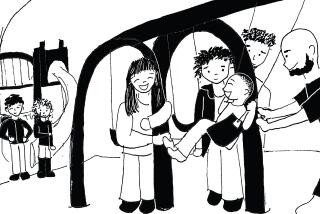Cambodian-American Bridges Cultural Gap
- Share via
ST. PAUL, Minn. — Growing up in Cambodia, Vuthy Pril hunted with a slingshot to bring food home to his family.
“In my village, I could hunt from my backyard if I wanted to,” he said. “I could trap in my neighbors’ rice paddies.”
With no enforced government regulations and no such thing as trespassing, Pril hunted “anything you can imagine,” including squirrels, birds, raccoons and a number of animals for which he doesn’t know the English words.
It’s quite a different environment than Minnesota, where plenty of laws are enforced to keep residents’ passion for hunting and fishing from depleting natural resources.
In October, Pril became Minnesota’s first Southeast Asian conservation officer and one of the first in the country. Among the 35-year-old officer’s duties: bridging the communication gap between the Department of Natural Resources and the state’s exploding Southeast Asian community.
He completed his field training on Feb. 16 and became a stationed officer--his station, for now, being a spare room in his house just outside St. Paul.
“It’s not all that big, but it works,” he said.
The DNR is looking for office space in one of the predominantly Southeast Asian areas of St. Paul and Minneapolis.
After his first day in the field, a long day of checking snowmobilers and ice fishermen around the Twin Cities, Pril wasn’t a bit tired.
“It’s fun,” he said, laughing. “I’m excited.”
He knows he still has a lot to learn.
He has driven a snowmobile only once and has never driven a boat, both of which he’ll be issued as part of his official duties. He has little experience with a gun. He needs to brush up on his knowledge of waterfowl. He doesn’t know exactly what his patrol area will be.
“Now that I’m on my own, it’s a lot of pressure,” he said.
A look at the DNR’s citation records over the last decade shows why the agency is training Pril and others like him.
Hundreds of Southeast Asian names like Vang, Her, Xiong, Yang, Lee and Le dot the records --most of them cited for violations that would seem obvious to English-speaking, Minnesota-reared outdoorsmen and women.
Many weren’t wearing blaze orange when hunting. Others were keeping too many fish, trespassing or target shooting in restricted wildlife management areas.
Many can’t read either English or their own Southeast Asian languages, making signs or pamphlets ineffective. Another source of misunderstanding is the survival-oriented background of many Laotians, Cambodians and Vietnamese.
“It’s a whole cultural thing,” said Bill Bernhjelm, the DNR’s enforcement chief. “If you come from subsistence, two squirrels are always better than one. The idea of bag limits is a foreign concept.”
A precise number for Minnesota’s rapidly growing population of Southeast Asians won’t be available until after the 2000 census, but immigration officials say most of the state’s immigrants from abroad now come from Southeast Asia.
Pril spent his early years on a farm in Cambodia until communists overthrew the government, separating Pril and other children from their families. They worked from dawn to dusk in the jungle.
Pril and his family moved to Minnesota in 1983. He graduated from high school and got a psychology degree at the University of Minnesota. After five years at a social service agency, he decided he wanted to get into law enforcement and heard about the DNR’s new Enforcement Liaison Community Officer Program, or ELCOP.
The United Cambodian Assn. of Minnesota, where Pril worked previously as a drug counselor, encouraged him to apply.
“This is a person that can speak the same language and can educate the people how to do something according to law,” said supervisor Khon Kong.
Although Pril has an edge in appreciating why Southeast Asians don’t obey or understand hunting and fishing laws, he knows bridging the cultural chasm won’t be easy.
“If they have a chance, they will take too many fish,” he said. “I hope when I’m out there, they’ll respect me and not say, ‘You’re Cambodian--why not just let me go?’ ”
During training he didn’t have problems with that, but he had another officer with him.
“It’ll be a different story when I give them tickets,” he said.
Pril expects to spend about 40% of his time teaching Southeast Asians about outdoors-related laws and 60% enforcing those laws.
He and three others were selected in 1997 from 72 applicants to go through the liaison program, funded by a two-year, $250,000 appropriation from the Legislature. The two most important qualifications were being bilingual and being involved in the community. The other candidates, two from Laos and one from Vietnam, should be sworn in later this year.
Legislators allocated an additional $260,000 to put at least three more officers through the program during the next two years. Two candidates have been chosen from a pool of 47 applicants and should complete their training in about two years.
Bernhjelm said the program already seems to be making a difference. Other officers are more aware of Southeast Asian issues, and Pril is learning what it takes to be a conservation officer.
“He’s much more assertive and outgoing,” Bernhjelm said. “He’s got the look in his eye.”
More to Read
Sign up for Essential California
The most important California stories and recommendations in your inbox every morning.
You may occasionally receive promotional content from the Los Angeles Times.












